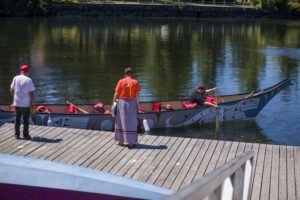For Camosun School of Access dean Ian Humphries, the private smudging ceremony and launch of Camosun’s new Indigenous canoe into the Gorge waterway on Monday, July 21—National Indigenous Peoples Day—was a special experience. Considering the many hundreds of bodies of Indigenous children that have been discovered across Canada recently, Humphries knows work in reconciliation will be done for many, many generations to come.
“The timing was pretty wild,” he says. “I was sending out some emails about the canoe… and then we got the news out of Kamloops. That was kind of like a punch in the gut. With all the focus on going forward, news like that kind of makes us go backwards, or it felt that way.”
One of the highlights for Humphries during the launch of the canoe—which features art by Camosun alumnus and City of Victoria Indigenous artist in residence Dylan Thomas—was singing and chanting that took place under the Craigflower Bridge.

“It was a hot day,” he says. “We were in the shade, so that was nice, but [we] started doing some chanting in there and the echo coming off the bridge—it was really, really cool.”
Humphries says the experience was positive, but as the last few weeks have highlighted, there is a long way to go.
“Our work’s not going to be done for many generations. I was looking for the hope, and how to make things better going forward,” he says. “It was really positive getting out on the canoe.”
The college is working to move forward into phase two of the Calls to Action from the Truth and Reconciliation Commission of Canada (TRC); Humphries says he took some time to pause and reflect on what he wants to see happen at the college moving forward. (The calls to action are split into two parts, or phases: the first is “legacy,” which is calls 1 to 42, and the second is “reconciliation,” which is calls 43 to 94).
“I’d like to see [Indigenous Studies] courses as electives in more areas of the college,” he says. “That’s something we’re planning on.”
A task force at Camosun was assembled during phase one and Humphries says something similar will be done for phase two. The challenge at this point is there are “different people with different thoughts” regarding what goes in phase two for the college.
“There’s lots of work to be done on anti-racism, for example,” he says. “How does that fit in there?”
As well, preferential hiring for Indigenous people—which came into effect at the college as of July 1—is of particular importance to Humphries.
“Certain areas identified in the TRC’s Call to Action—for example, criminal justice, social work, public administration—there’s certain areas there where we feel strongly that there is value in offering preferential hiring to people of Indigenous ancestry with appropriate levels of knowledge,” he says.
Through the office of the BC Human Rights Commissioner, Camosun has been given approval to implement the preferential hiring as of July 1, says Humphries.
“We have trades training that goes out in Bella Coola, or wherever else, we’ll turn on the preferential hiring there,” he says. “Also, if we’re doing anything that is funded by the Indigenous community, it’ll get turned on there, as well. There’s a number of places… we would be seeking people with Indigenous ancestry, but also, lived experience. In and of itself, to have Indigenous ancestry, that’s not enough.”
Humphries draws attention back to institutional learning outcomes related to Indigenization, as well as the possibility of asking questions to everyone applying for jobs at Camosun about how they plan to support Camosun in responding to the TRC’s Calls to Action.
“I wouldn’t mind seeing a question like that put to everyone that applies for work with the college,” he says.
The reason phase one was so successful at the college, says Humphries, is because of the work that Camosun president Sherri Bell did around accountability when Camosun first made an Indigenous and Reconciliation plan in 2015 that consisted of 39 actions for the college to take in response to the TRC’s Calls to Action.
“Each of the 39 recommendations,” he says, “when we built the project charter for it, had a college executive team member’s name beside it.”
